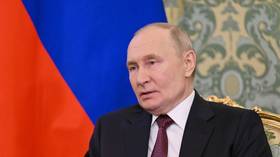Forget OPEC: China now moves the oil markets

Not so long ago, oil prices would surge or plummet on just a whisper from OPEC, who at the time held all the supply cards.
The mere hint that the world’s most powerful oil cartel was going to cut production could send oil prices up dramatically.
Those days are over.
When the cartel announced on November 30, 2016, that it would cut production for the first time in eight years amid a major oil-price crisis, the market cheered. Before any cuts even happened, the sentiment alone boosted prices from a $50.74 close on that day to $54.94 at the close on December 5th, 2016.
From that point on, at least up until recently, OPEC could drop the vaguest hint about production, or even think about production, and it would move the market--no fundamentals necessary.
Also on rt.com All eyes on OPEC as another oil glut loomsThis phenomenon was still going strong in the last quarter of 2018. On December 7, 2018, OPEC and its allies announced that they would do what they do best: rally together and withhold oil production from the market. OPEC promised to take 1.2 million barrels of oil daily off the market, sending oil prices up from $57.83 at the close on December 6th to $61.71 at the close on December 7th.
By July 1, 2019, when OPEC and allies agreed to extend production cuts for another nine months, the bling in cartel announcements had already been dulled. Not only did oil prices fail to jump, they moved in the opposite direction--not because of the OPEC cuts; rather, because the market was no longer that interested. From a closing price of $67.52 on June 28th, Brent dropped to $65.01 on July 1st, and then plummeted to $62.72 the following day.
Since then, it’s managed to move the needle only slightly, one way or another.
There’s A New Whisperer in Town ...
… and it’s not Iran, or even US shale. The supreme market mover is China.
The residual effect of the US shale boom changed all that. In the aftermath of the oil-price crisis that was largely caused by massive new output in US shale plays, the market began to be moved more by weekly crude inventory data estimates from the American Petroleum Institute (API) and the “official” data on the same that would follow the next day from the Energy Information Administration (EIA).
Also on rt.com Discovery of massive oil deposit could be a game-changer for ChinaNow, all those acronyms have been overshadowed in the market by the ongoing trade war, global economic data, and demand signals coming out of China.
The biggest surge in oil prices this year was prompted by September 14 attack on Saudi Aramco’s oil facilities, but that 15-percent surge could not be sustained as dramatic as the attacks were, and despite the fact that they took five percent of the world’s oil off the market instantly.
Within a day, it was clear to traders that the Saudis would get things up and running quickly, and that there would be no signfiicant supply crisis.
Also on rt.com Space economy: China wants to set up $10 trillion Earth-Moon economic zoneAttention immediately refocused on China.
Now, the faintest whisper of a potential ‘deal’ to end the trade war, or a hushed signal that things are going to get worse moves the oil needle most volatilely.
On September 4th, oil prices jumped over 4 percent just on Chinese economic data alone. Immediately prior to that, the market was seething with fears about a weakening global economy.
It still is, but with each release of new data and indicators, it either remembers or forgets those fears all over again.
On October 10th, oil hit a two-week high on sentiments that a trade war deal was within reach in the form of a ‘partial’ deal. The market viewed talks as the biggest breakthrough in the 18-month trade war.
As it turns out, it wasn’t, and oil pared its gains--again.
Each time the trade war talks, the oil market listens much more closely that it listens to Iran’s shooting down of a US drone, or even Iraq’s disintegrating into potential civil war.
Also on rt.com US-China trade down $67 billion this year, hurting both economiesCertainly more than it’s listening to OPEC these days. It’s even listening to Trump’s Twitter account more than it is the oil cartel.
But the trade war is the biggest threat to oil prices by far, and the market understands this.
The trade war is depressing economic growth in Asia and the US because it increased the costs for businesses importing goods and raise prices for consumers. That means a slump in economic growth, which always translates into a slump for energy.
OPEC Conceded Its Own Defeat
OPEC has lost the supply battle.
No matter how long it continues with its cuts, it’s not putting a dent in oversupply. And that’s even with a Libyan civil war part II, crippling sanctions on Venezuela and Iran, and the most brazen attack on the world’s biggest producer that one could imagine.
Still, OPEC is plodding along with supply cuts and losing market share left and right, while US shale just keeps producing and producing. In other words, OPEC is giving up production and the US is scooping up market share.
So now, while US crude inventory data can move the oil-price needle every week, more than any statements coming out of OPEC can, if you’re playing oil’s volatility, it’s all about the trade war.
This article was originally published on Oilprice.com














